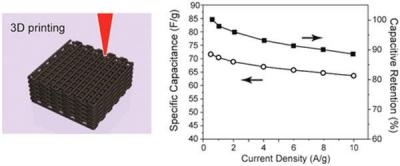Scientists at Lawrence Livermore National Laboratory and UC Santa Cruz have demonstrated what might be the world's first 3D-printed graphene composite aerogel supercapacitor, using a technique known as direct-ink writing. The researchers suggest that their ultra-lightweight graphene aerogel supercapacitors may open the door to novel designs of highly efficient energy storage systems for smartphones, wearables, implantable devices, electric cars and wireless sensors.

The key factor in developing these novel aerogels is creating an extrudable graphene oxide-based composite ink and modifying the 3D printing method to accommodate aerogel processing. The 3D-printed graphene composite aerogel (3D-GCA) electrodes are lightweight, highly conductive, and exhibit excellent electrochemical properties. Supercapacitors using these 3D-GCA electrodes with thicknesses on the order of millimeters display exceptional capacitive retention (ca. 90% from 0.5 to 10 A·gâ1) and power densities (>4 kW·kgâ1).
In their ink, the researchers used a GO concentration of 40 mg·cmâ3, and added hydrophilic fumed silica to serve as a viscosifier to meet the rheology requirements of reliable flow through a fine nozzle under shear force and shape retention after deposition. GNPs were added along with the reactants used to induce gelation postprinting via organic solâgel chemistry.
The researchers say that graphene-based inks have a clear advantage over other carbon-based materials due to their ultrahigh surface area, lightweight properties, elasticity and superior electrical conductivity. The graphene composite aerogel supercapacitors also are extremely stable, the researchers reported, capable of nearly fully retaining their energy capacity after 10,000 consecutive charging and discharging cycles.
Over the next year, the researchers intend to expand the technology by developing new 3D designs, using different inks and improving the performance of existing materials.